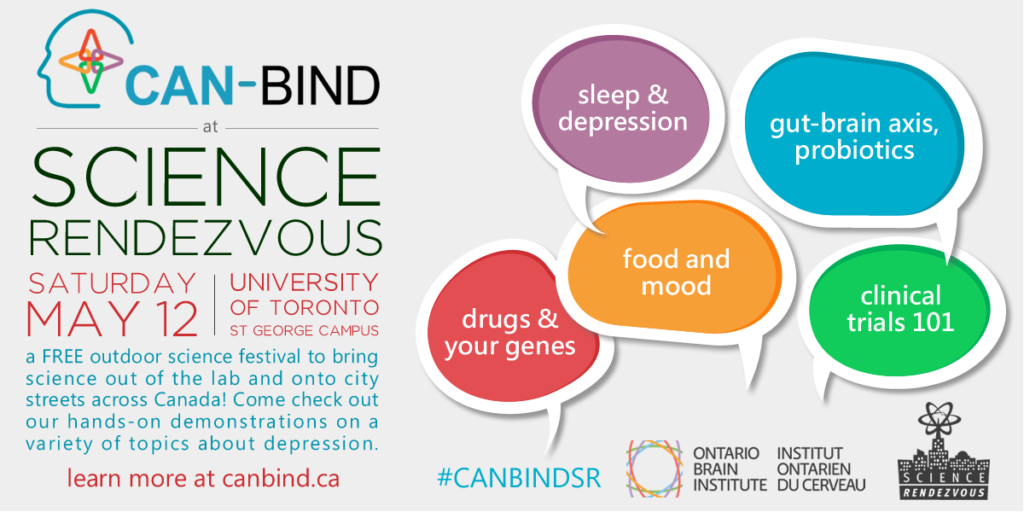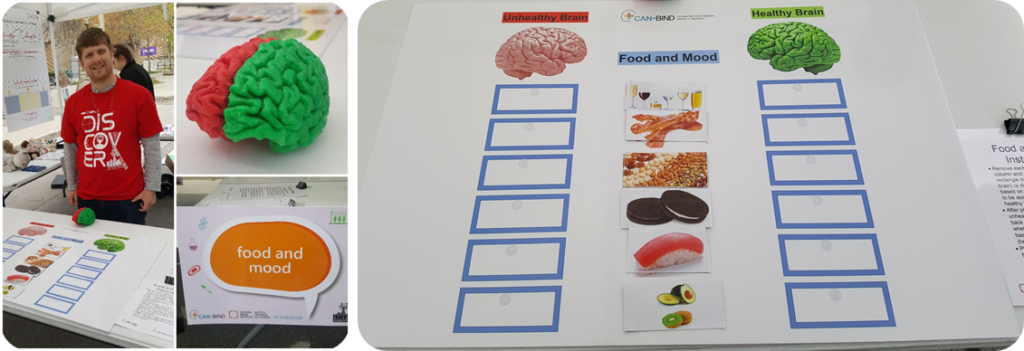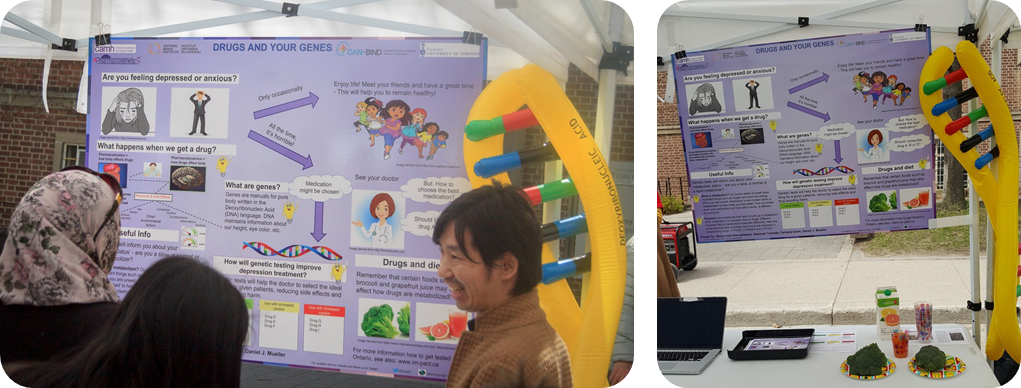Event Summary: CAN-BIND at Science Rendezvous

Science Rendezvous is a Canada-wide festival that engages the public in science, technology, engineering, art and math (STEAM). Interactive educational activities are organized by universities and research institutes across Canada to inspire curiosity and interest in STEAM in those young and old. The 2018 event was held on Saturday, May 12, and CAN-BIND hosted a booth at the University of Toronto’s St. George campus. With activities about how the gut microbiome, food, sleep and genes can influence mood, and a life-sized board game about clinical research studies, our booth drew over 625 visitors!
This year, CAN-BIND had a record number of 19 volunteers involved in Science Rendezvous, including Community Advisory Committee (CAC) members, graduate students, Postdoctoral Fellows, Principal Investigators, and research staff. In addition to hands-on activities, our booth featured hourly raffle prizes, including plush microbes and copies of The Psychobiotic Revolution by Scott C. Anderson, written with leading gut-brain researchers, John F. Cryan and Ted Dinan. Read highlights below and view a summary infographic here.
Sleep and depression
Why do we need sleep? How long should kids and adults sleep, on average? Dr. Benicio Frey and PhD candidate Anastasiya Slyepchenko from McMaster University led three hands-on activities about the importance of sleep and answered questions about the relationship between sleep and depression.

Download the sleep handout for kids
Download the sleep handout for adults
Gut-brain axis and probiotics
What do microbes in your gut have to do with your mood? Dr. Jane Foster from McMaster University, and Rachael Horne and Cassandra Francella from her team educated visitors on the gut-brain connection. Dr. Foster’s team also provided colouring pages that highlighted different parts of the gut-brain axis, including the enteric nervous system and the gastrointestinal tract. Follow @jfosterlab on social media to stay up to date on the latest gut-brain research.

Download the microbes and mood infographic
Download the gut-brain colouring pages
Food and mood
Do you know which foods are good for your mood? Stephen Daniels, a PhD candidate from Dr. Francesco Leri’s group at the University of Guelph led a game where visitors could guess whether certain foods—like nuts, cookies and sushi—are likely to have a positive or negative impact on mood.

Drugs and your genes
The answer to whether or not a medication, such as an antidepressant, is suitable for a specific person may lie in our genes. A lot of research is being done to develop genetic tests that may help doctors select the ideal drug for each patient. Team members from Dr. Daniel Mueller’s team from the Centre for Addition and Mental Health (CAMH) talked to visitors about genetics and drugs, and about how certain foods can influence how we metabolize, or ‘process’, different medications.

Clinical trials 101
What are the major steps of a clinical trial? Have you ever participated in one? The key steps of a clinical trial, including screening, informed consent, study visits, data collection and analysis, and knowledge translation, were explained through a life-sized game of snakes and ladders. Read about the key steps in the Clinical Trials 101 leaflet, and learn more about the research process here.
Art station – Draw a brain…or a walnut!
Visitors were encouraged to get creative and draw something that looks like a brain at our art station. Drawings included walnuts, broccoli, spaghetti, and a blob fish! Check out some of the masterpieces in the photos below.

Thank you to all of our visitors who participated in our hands-on activities. We hope you enjoyed the day. Have photos that you’d like to share with us? Tag us on social media @CANBIND. Learn more about Science Rendezvous and how to get involved next year at http://www.sciencerendezvous.ca.
Photos by Andrew Kcomt and Amanda Ceniti
Written by Janice Pong
